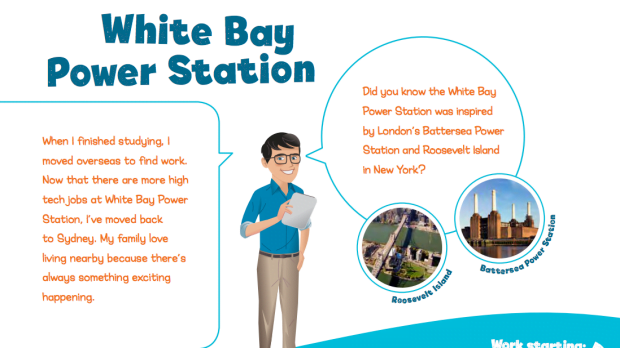NSW Labor has labelled a children’s book that highlights the benefits of the government’s multi-billion dollar re-development of the Bays Precinct in central Sydney as “propaganda” and demanded it be withdrawn from the state’s classrooms.
The picture book, pushed into schools by the NSW government’s property development arm, UrbanGrowth, also comes with a teacher’s guide on educating students about the project that will encompass the Ultimo, Rozelle, Pyrmont and Glebe foreshore.
“It’s a big picture, very visual, colourful book,” says Belinda Thompson, the schools manager for UrbanGrowth NSW in a video promoting the resource.
The video also features UrbanGrowth’s public relations specialist, Holly Langler, giving a lesson to children in a public primary school.
The book does not give alternative voices who might be concerned by the development or to those who work in the area such as maritime contractors.
On Thursday, Labor leader Luke Foley called for the withdrawal of the resource. “This government propaganda push is what you would expect to occur in a third-world banana republic,” he said.
It is the second school-based public relations initiative from the Baird government in the past year after it awarded a $2 million contract to Elton Consulting to spruik a rail line to primary and secondary children titled: “How the Sydney Metro Northwest will change their communities for the better”.
Despite being among the features highlighted by the children’s book, the government has yet to outline a significant transport proposal that will allow the tens of thousands of residents and workers to move efficiently into the Bays precinct everyday.
UrbanGrowth’s own CEO, David Pitchford said last year the area would be a “disaster” without a proper transport plan beyond the existing light rail.
“We’ve got to address that really important question of mass transit and introduce a whole range of things that will be unpalatable to the government in terms of the level of investment – but without that, it will be a disaster,” he told the NSW chapter of the Australian Institute of Architects.

The picture book also features colourful characters spruiking the attractiveness of the area.
“When I finished studying, I moved overseas to find work. Now that there are more high tech jobs at White Bay Power Station, I’ve moved back to Sydney. My family love living nearby because there’s always something exciting happening,” says one bespectacled “tech” worker.
But a single developer has yet to be appointed to construct the White Bay technology hub after the government rejected 13 private sector proposals for the site’s transformation because it relied too heavily on housing density to offset the cost of remediation.
Among other features, the book also highlights an imaginary campus promoted by a laptop-carrying student.
“I looked all over the world for the best courses and chose the new campus at Glebe Island. I love that it’s so close to the port, the new tech hub at White Bay Power Station and other marine activities,” she says.
But universities and educational institutions are yet to commit to the area despite UNSW, UTS, Macquarie and the University of Sydney all voicing interest.
On Thursday, Mr Foley said schools should not be grounds for political influence.
“Our primary schools should stick to the basics and focus on teaching reading, writing and arithmetic,” he said.
NSW Education Minister Adrian Piccoli said the independent Board of Studies creates the curriculum used in NSW schools.
“Decisions about teaching resources – whether they are to be used in geography classes, or music, or maths – are made by the principal,” Mr Piccoli said.
“Teachers will often incorporate local areas of interest, to give students real-world examples to further their understanding of curriculum.
“But promoting government projects is not part of the syllabus or the curriculum. Never has been, and never will be.”
A spokesman for UrbanGrowth said the book was specifically designed as part of a collaborative learning program to support the Board of Studies geography syllabus, which focuses on connectivity, sustainability, environment and liveability across all school years.
“It was produced at the request of schools seeking a range of education resources to support those classes. It is up to individual schools how they use the booklet,” he said.
[Source:- smh.au]

